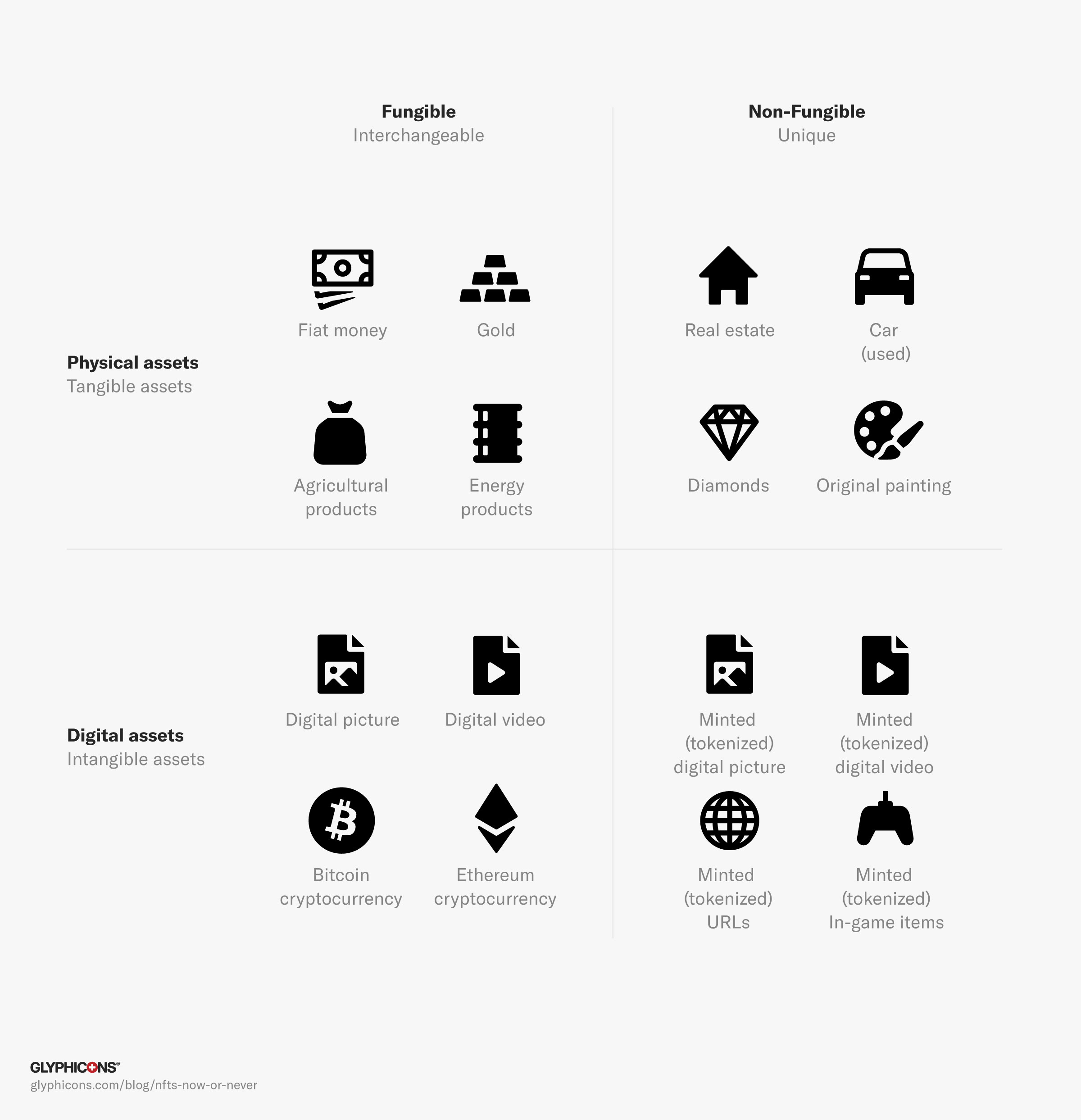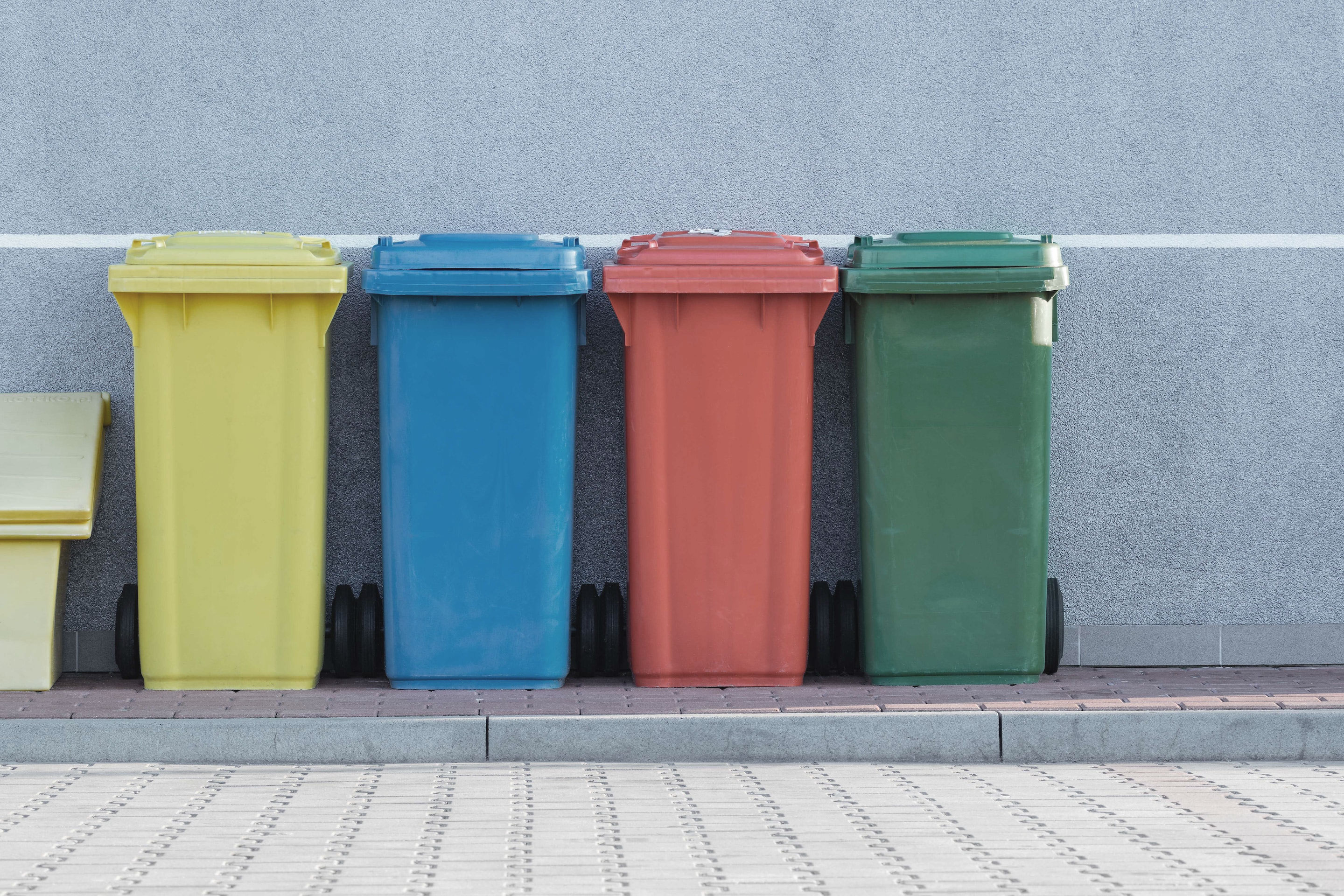NFTs, now or never
October 25, 2021By Jan KovaříkThoughts

Unless you spent the last few years isolated somewhere alone in the wilderness, you must have heard about NFTs. A new form of buying, selling, and creating digital art – today often referred simply as cryptoart. The market with cryptoart is growing every day and people are trading, as there's no tomorrow.
I’ve been thinking lately about how I could use it, as a graphic designer, to create something special for my customers, so I’ve been exploring this new fascinating world of cryptoarts for a few months now and in this article, I’d like to explain some basics for newcomers, and also describe my personal experience and opinion.
To be clear, I’m neither an expert in this field, nor the crypto enthusiast, so please, take everything in this article with a pinch of salt1. Also the following text is not intended to be investment advice, but rather my personal opinion on the current state of affairs around this new phenomenon.
Is this article for you?
Part 1 (The basics of NFTs)
In the first part, I sum up briefly everything fundamental related to NFTs. I’m intentionally mentioning only the most important terms and facts, so people without much experience with NFTs can quickly grasp how it works. The first part contains a few personal observations, for which you may want to read it anyway, even if you know how NFTs work.
- What's what in the world of NFTs
- What sets the price of NFTs
- Create, buy and sell cryptoart
Part 2 (My personal story/opinion)
If you’re already buying, selling, or even creating NFTs, you might want to jump right to the second part of the article – it starts with: “How I thought NFTs were working”. The second part is more my personal story, how I wanted to buy and also plan to create and sell my first piece of cryptoart and how it ended up.
- How I thought NFTs were working
- NFTs and their impact
- So, is it now or never?
What's what in the world of NFTs
So, as you probably already know, NFTs are directly tied and dependent on a blockchain – not on a certain type of digital cryptocurrency, but rather on blockchain technology itself.
Non-fungible tokens (NFTs) represent digital certificates of authenticity powered by blockchain technology. It’s a method of tracking digital ownership. In plain words, NFTs are extra data, information, stored in various cryptocurrencies using blockchain.
Cryptocurrencies used for NFT transactions
Information about NFTs is stored in the Ethereum blockchain (through smart contracts). Other blockchain-based cryptocurrencies can implement their own version of NFTs, but as for today, the most used cryptocurrency for NFT transactions is Ethereum.
Fungible vs non-fungible
Fungible means interchangeable
One dollar bill, one Bitcoin or one Ethereum for that matter, is perfectly fungible because it can be replaced anytime by another piece of one dollar bill (or any other currency, fiat or crypto) and it will always have the same value, no matter what’s its origin, form or appearance.Non-fungible means unique, non-interchangeable
Simply said, this can be literally anything that can't be substituted directly for something else. So, each piece has its own unique value. It can be a painting, digital picture, sound, video, you name it. But it can be just as good as a limited series of anything, it's important to remember this for later.

What all can become NFT
Apparently almost anything at the moment. From a Tweet to URL, over more traditional picture files, sound files, video files, you name it.
What's tokenized (minted) NFT
Your cryptoart (whatever it is) needs to be imprinted as an asset on the blockchain, to be traded as NFT. So, to mint an NFT means to verify and store information about the ownership of a certain cryptoart in the blockchain (for example inside the Ethereum blockchain).
Where's NFT stored
What’s the most important thing to understand here, is the fact, that your cryptoart – the file itself, is not being stored or uploaded anywhere during the minting process, just the hash of it. And that’s also the only thing you’re buying or selling (usually) when trading NFTs.
What's a hash of a file
You can think of a hash as a string of seemingly random numbers and letters, an ID, which doesn’t allow you to re-create your digital art, but serves as an identifier for that one file in the blockchain. It simply confirms its uniqueness.
What sets the price of NFTs
Did you hear about Mike Winkelmann (better known as Beeple) who sold a single piece of digital collage for $69,3 million? Or about one of the 10,000 unique pixelated faces from the CryptoPunks collection, namely CryptoPunk #7523, sold for $11,8 million? The list of the most expensive NFTs goes on and on.
NFTs can be bought for a fixed price or are often offered in form of an auction. It means that there is a floor price, upon which people bid till the moment, there is nobody else willing to pay more.
The price of NFTs and their value is formed by many factors, similarly as it is with regular art. But the most important determinants are scarcity, uniqueness, and the most overlooked aspect – the size of the audience.
Uniqueness
NFTs can be a one-of-a-kind piece of art sold as one file only or it can be a whole series of similar pieces, distinguished by their serial number, color, shape or they may differ only in slightly different appearance and or fictional characteristics. It’s actually up to the artist to create this backstory for their product.
Scarcity
The author of the cryptoart can re-sell it as many times as he wants. These NFTs are usually sold in various “editions” and “limited-series”. By intentionally setting the limit of how many pieces of the same cryptoart are available, the author is creating various levels of scarcity.
The size of the audience
This is probably the most important factor, often neglected. While you can’t calculate the price of NFTs solely based on the number of followers, it’s pretty safe to presume that the bigger the number, the bigger the support of all these people and their willingness to buy your art.
With an audience large enough, you can ask for money or even for something that would be otherwise absolutely worthless, if it came from somebody unknown. And this isn’t something new or unfair, in the world of traditional art, this has been always the case. In fact, the most famous artists did not gain their fame until after their deaths.
Art was never only about "the thing"
For example, when you’re buying a physical piece of art, you don’t buy only a nice picture in a frame or perfectly carved statue, you’re buying also a piece of the author’s soul, piece of his life, experience, emotions and a story that is imprinted in it.
You see, now we’re getting somewhere deeper. People often don’t understand, that Beeple’s opus isn’t just a collage of 5,000 images, it’s also a story of a graphic designer, Mike Winkelmann, who sat 5,000 days behind his desk, drawing every day one piece, for more than 13 years in a row. His NFT also reflected directly his story and his personal evolution as an artist.
Create, buy and sell cryptoart
You can download a picture, video, sound, a copy of almost anything that was ever sold as NFTs and “consume it” with your senses, such as, eyes or ears, but only one person on the planet can claim that he/she is the owner of its digitally signed NFT version.
Wait, so will I own the art or not?
This often causes a great deal of confusion. Firstly, do not mistake ownership of NFT with copyright ownership, as owning an NFT doesn’t mean that you own the copyright to the art, it always stays with the author.
In fact, the author will usually retain all reproduction and other rights. The owner of the NFT owns a digital certificate, that can be found and verified on a blockchain, that verifies ownership over asset.
just setting up my twttr
— jack⚡️ (@jack) March 21, 2006
It’s the same as if you’d go to a gallery and buy an original framed painting from your favorite artist. You’d get a receipt or a rather contract, that would prove your ownership of the original, but you couldn’t make any copies of this art or claim that nobody else can use/see its copies, photographs, etc.
Ok, get it, so why are people buying NFTs in the first place?
I think that the majority of people buying NFTs today are doing so as an investment. Simply said, they don’t want to miss their chance and want to make some money when selling it to somebody else later. Some want to support their favorite artist and that’s fantastic, as they can do that almost directly.
Size of commissions for artists and marketplaces
What’s also great about NFTs is the fact, that when you sell your art piece through the digital marketplace, it takes usually only from ten to fifteen percent, while when sold in a traditional gallery, it can be half of the price or even more. Oh, and one more thing – the artist can get even commissions, every time the art is resold.
What drives this thing
There is a ton of videos on YouTube with titles like “Flipping X NFTs for X much in X days” or a sheer amount of articles that start with: “Look, X making X figures just with NFTs”, following closely with tutorials on how to create your own NFT collection and start making money with it in no time.
So yes, in short, money is the main drive here, there is no doubt about it. While there is nothing wrong about it in general, it has its hidden side and (unnecessary) side effects, that many don’t know or just ignore – I believe it’s just an unawareness for the most. More about this in the second part that starts below.
How I thought NFTs were working
When I first read about NFTs – actually I heard about them on YouTube, I was immediately hooked. A new, more direct and fair way, how to sell or buy digital art and it’s somehow connected to the blockchain? Great, I had used cryptocurrencies before and had some experience with them, so it all seemed like the flawless method of how to buy or trade digital art.
From a regular buyer’s perspective, I thought about it as a cool, modern way how to collect digital art and maybe re-sell it later, on a secondary market. Why not, when I was young, I was collecting cards with hockey players and I remember my excitement when trading them vividly, so I was imagining it to be a similar experience.
It was time to buy my first NFT
It all seemed crystal clear. I selected a few projects that caught my attention, created an account with a recommended crypto wallet, and sent a small amount of Ethereum in it. I was set to make my first purchase.
NFTs and their impact
As I was waiting for the presale to start and was ready to mint my first cryptoart, I decided to devote some extra time to research for more information about everything underlying NFTs, as I was hyped and wanted to be as ready as possible.
I stumbled upon the article wrote by Memo Akten2, who spent the last few months investigating and collecting data tied directly to NFTs and their direct impact on the environment. Reading his article, I’ve found out that there is an imaginary second side of the coin, that I was not aware of. And for me, it changed everything.
The sky's the limit
Anybody can make a cryptoart from almost anything thinkable. It’s so easy and affordable, right?
While some of these “arts” are not even meant to be taken seriously, but rather to entertain – I’m talking about Tweets, screenshots of Tweets, screenshots of the screenshot of… you get the idea – a significant number of these NFTs are being minted, tokenized as we speak and each such NFT means a transaction (or rather multiple transactions) in the blockchain, and that means mining, and mining means high energy consumption. A lot.
Proof of work problem
Cryptocurrencies like Bitcoin or Ethereum, are currently using "Proof-of-Work" (PoW) as their consensus mechanisms. Miners are competing with each other to solve complex mathematical equations to validate transactions in the network, to get the reward (cryptocurrency).
It's probably no surprise to you, that all these calculations require an enormous amount of electricity.
I was aware of the fact that "PoW" is made to be inefficient by default for security reasons, but what I didn't fully realize is that in connection with that, every click of the mouse, every tiny operation tied with NFTs (selling, buying, minting) means a transaction (or even multiple transactions at once) in the blockchain and every such transaction means mining and that means high energy consumption.
How much? To get a better idea about how big a carbon footprint of an average NFT is, I'll quote from Memo Akten's article2:" This single NFT’s footprint is equivalent to a EU resident’s total electric power consumption for more than a month, with emissions equivalent to driving for 1000Km, or flying for 2 hours. "
Wow, that's crazy, it can't be, right? Well, if you're amazed by this number as I was, wait for it, it's just a tip of an iceberg.
-
Proof of work problem multiplied by editions
As we stated above, cryptoart is often offered in so-called "editions" or "limited-series", when an artist is selling either multiple numbers of the same NFT or NFTs that are just a visually pre-generated combination of multiple elements, offered for example in tens of thousands of pieces.
Yes, you can now multiple NFT’s footprint directly with the number of the NFTs in these editions. Take a look on an example with an artist who generated for 6 months 1500 editions of 12 NFTs – I'll quote Memo Akten2 again:
" In under half a year, one artist’s multi-edition NFTs have a footprint of 260 MWh, 160 tonnes of CO2 emissions. "
I knew that these PoW based blockchain transactions are not particularly "eco-friendly", but I imagined it's somehow 10 % less efficient than the transaction with fiat currencies. And that it's just a temporary hiccup, to be solved in a few upcoming months – or maybe it's already solved, right?
Nah, it's not, at least not for now. Ethereum 2.0 is going (promising) to move to a new mechanism, "Proof-of-Stake" (PoS) and it promises almost zero energy consumption (in comparison to PoW), but it looks like this change is technically very difficult, still hasn't the needed support of the community and is being postponed every year.
More information about this issue
I recommend reading a few articles linked on Memo Akten’s website3 or The Environmental Cost of CryptoArt4 by Duncan Geere.
I bet you find other sources, but these alone were enough for me, to make me stop and think, before buying or creating NFTs just for fun or as an experiment.
Is it really now or never?
With all the buzz and literally gold rush around NFTs at the moment, you may get easily very excited as I did. You may have a feeling that it’s a really pressing matter, something you shouldn’t ignore, or you may lose the opportunity to make some money. Or maybe you’re just a tech fan as I’m and want to simply try it out.
Don't want to miss the train
Also, it might be even more tempting for you, if you believe that you somehow “missed” the last opportunity with crypto, and if you believe, that because you didn’t purchase some cryptocurrency a while ago, you might lose a fortune. Of course, reasoning like this is largely meaningless, as you can’t evaluate your decision retrospectively in such a simplified way. You’d have to consider also the infinity of other variables, that could, maybe, only potentially, lead to the result of becoming a millionaire.
So no, if you’d bought bitcoin 10 years ago5, it’s only a very small chance you would be rich today, at least not as rich as you think and as you imagine.
It also depends on your priorities
I’m not an environmental activist by any means, actually, I was quite ignorant of the environment for most of my life. But a few years ago, I moved out of the city with my partner and it changed us both.

At first, our trash bins were overflowing every week. But gradually, as we started to compost more, sort and recycle every piece of material which passed through our hands, grow our own food, reduce unnecessary traveling by car, flying to vacation, etc. Not only we do feel better mentally, but also physically and the environment around us is cleaner and healthier. We simply try to be more aware and minimize our carbon footprint, at least the biggest ones we’re making.
Why do I tell you all this? Because you can imagine my awe, when I found out how big the impact of a single NFT is and how much our effort (and effort of other people) would be in vain simply by buying of a few pieces of cryptoart, just for fun or as an investment for that matter. What else would I exchange for money or profit?
Will there be any GLYPHICONS NFTs?
Yes, but not right now. First, I’ll wait until I find a marketplace with NFTs with as little ecological impact as possible. Other thing is, that I don’t like how senseless and confusing the market is at the moment. With so many fraudulent projects and authors driven only by the vision of quick profit, it seems a bit dingy and shady for me to create and try to sell my own NFTs in the same marketplace.
What about you?
As I said, I’m a tech person and I’m still very excited about NFTs. I’m not trying to discourage you, on the contrary! Maybe just choose to use NFT marketplaces, that are using less energy-consuming cryptocurrencies6 or artists selling their art for alternative cryptocurrencies, not based on the PoW model.
Simply pause and think for a second, before you hit that Buy, Sell, or Mint button, because tomorrow it doesn’t have to cause almost anything, but today, it may have a bigger impact than you think.
Cover image is photo from Jens Lelie on Unsplash.
25. 10. 2021 - Added sources
- If you believe that there's anything missing in this article, please let me know at glyphicons@gmail.com, I plan to update this article continuously.
- Source: The Unreasonable Ecological Cost of #CryptoArt (Part 1)
- Source: CryptoArt.wtf
- Source: The Environmental Cost of CryptoArt
- If you have some space in your inbox, I recommend to sign up for The Whippet.
- Source: CleanNFTs
